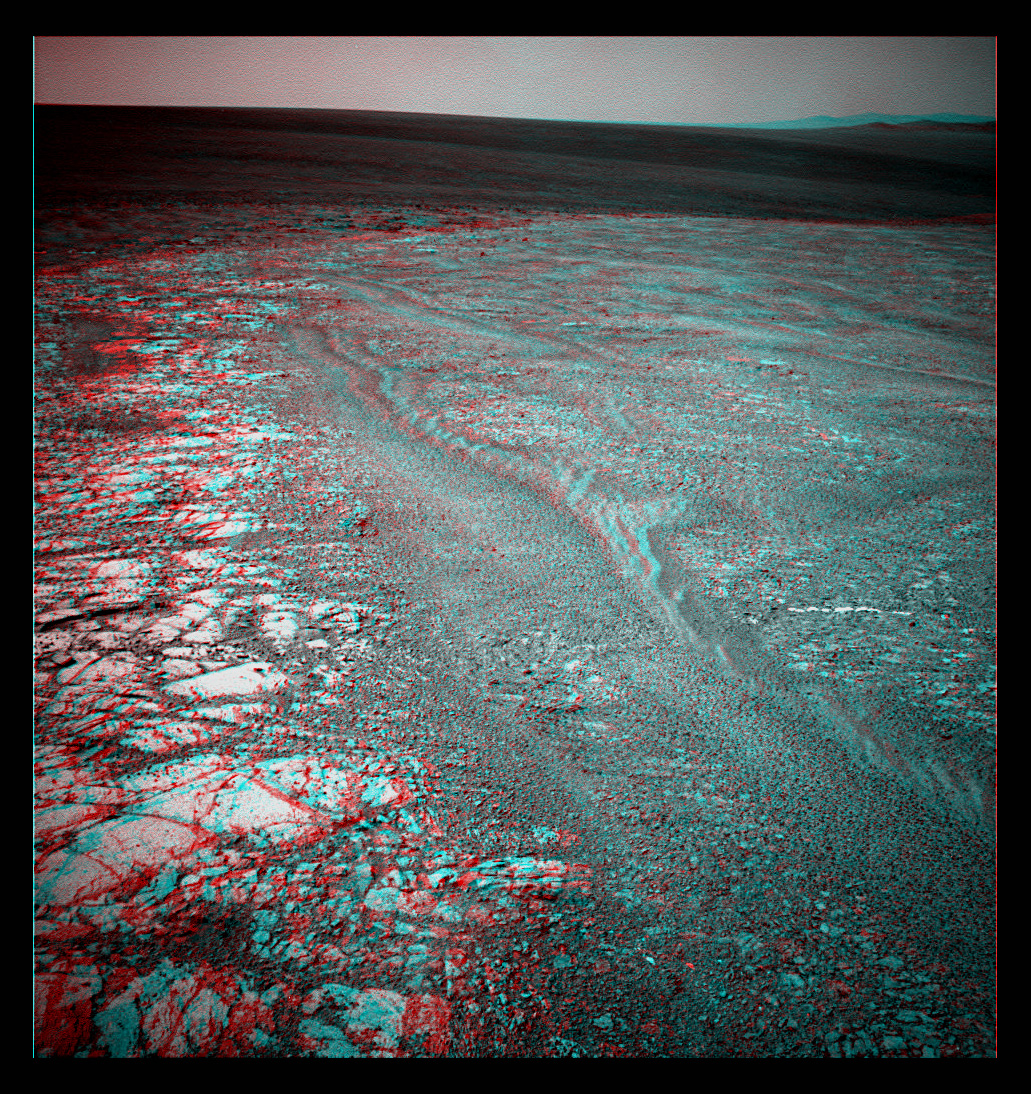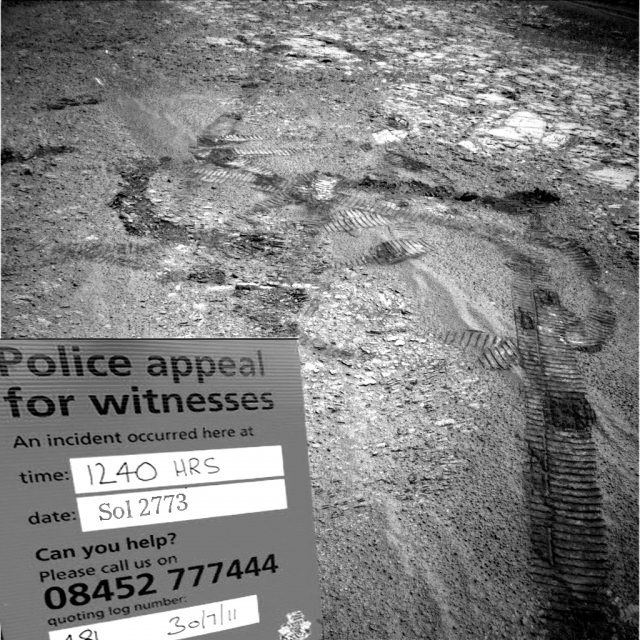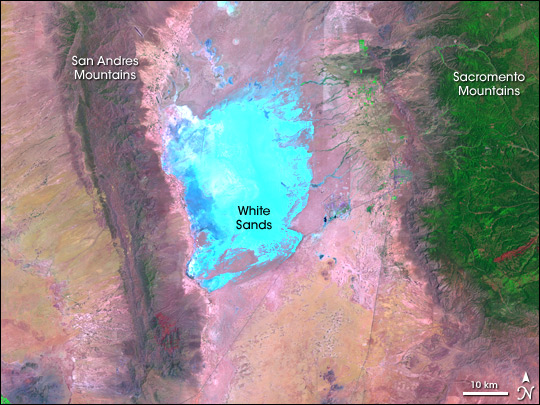The next MARS find by Opportunity
The next MARS find by Opportunity
NASA's Opportunity rover has come across a light-colored line of rocks that could serve as solid evidence for Mars' watery past — and help set the stage for the next Mars mission, due for launch this month.
Looking at the 3D image, it appears that there is another similar structure about 50' away from this one
Re: The next MARS find by Opportunity
They sure don't look like natural rocks to me. Besides the shapes, the color doesn't match the surroundings. I suppose that it's possible that a vein of 'something' got exposed, but dagnabit if'n it don't look like some one put it(them) there. Maybe Opportunity's shovel has enough oomph to dig a little around the sides??
To find the Truth, you must go Beyond.
Re: The next MARS find by Opportunity
I find the color rare but not much like with the real color of Mars in the picture.
- neufer
- Vacationer at Tralfamadore
- Posts: 18805
- Joined: Mon Jan 21, 2008 1:57 pm
- Location: Alexandria, Virginia
The Mongolian death worm?
BMAONE23 wrote:
Looking at the 3D image, it appears that there is another similar structure about 50' away from this one
http://en.wikipedia.org/wiki/Mongolian_death_worm wrote: <<The Mongolian death worm (Mongolian: олгой-хорхой, olgoi-khorkhoi, "large intestine worm") is generally considered a cryptid: an animal whose sightings and reports are disputed or unconfirmed. It is described as a bright red worm with a wide body that is 2 to 5 feet long. The worm is said to inhabit the southern Gobi Desert. The Mongolians say that the worm lives underground, hibernating most of the year except for when it becomes active in June and July. It is reported that this animal is mostly seen on the surface when it rains and the ground is wet. The worm is the subject of a number of extraordinary claims by Mongolian locals - such as the ability of the worm to spew forth acid that, on contact, will turn anything it touches yellow and corroded (and which would kill a human), as well as its reported ability to kill at a distance by means of electric discharge.
Though natives of the Gobi have long told tales of the olgoi-khorkhoi, the creature first came to Western attention as a result of Professor Roy Chapman Andrews's 1926 book On the Trail of Ancient Man. "It is shaped like a sausage about two feet long, has no head nor leg and it is so poisonous that merely to touch it means instant death. It lives in the most desolate parts of the Gobi Desert… None of those present ever had seen the creature, but they all firmly believed in its existence and described it minutely."
Czech explorer Ivan Mackerle described the animal from second-hand reports as a "sausage-like worm over half a meter long, and thick as a man's arm, resembling the intestine of cattle. Its tail is short, as [if] it were cut off, but not tapered. It is difficult to tell its head from its tail because it has no visible eyes, nostrils or mouth but may have them on some occasions. Its colour is dark red, like blood or salami...">>
Art Neuendorffer
- neufer
- Vacationer at Tralfamadore
- Posts: 18805
- Joined: Mon Jan 21, 2008 1:57 pm
- Location: Alexandria, Virginia
Homestake Hit & Run...Police appeal for witnesses
http://www.universetoday.com/91184/mars-rover-finds-a-turkey-haven-for-the-holiday/#more-91184 wrote:<<Behind Opportunity was a most intriguing light-colored rock outcropping – this one was named “Homestake.” The rover spent several days studying the rock – even doing what could be termed a cruel drive-by (or driver-over). You can see in this image below, how Oppy really created havoc and a mess with her studies of this region.
But seriously, many Mars rover fans are anxiously waiting to hear from the science team about what they found during Oppy’s close-up studies of this unusual rock outcropping.>> - Nancy Atkinson on November 22, 2011
Art Neuendorffer
Opportunity Finds Mineral Vein Deposited by Water
NASA Mars Rover Finds Mineral Vein Deposited by Water
NASA JPL-Caltech | 2011 Dec 08
NASA JPL-Caltech | 2011 Dec 08
NASA's Mars Exploration Rover Opportunity has found bright veins of a mineral, apparently gypsum, deposited by water. Analysis of the vein will help improve understanding of the history of wet environments on Mars.
"This tells a slam-dunk story that water flowed through underground fractures in the rock," said Steve Squyres of Cornell University, Ithaca, N.Y., principal investigator for Opportunity. "This stuff is a fairly pure chemical deposit that formed in place right where we see it. That can't be said for other gypsum seen on Mars or for other water-related minerals Opportunity has found. It's not uncommon on Earth, but on Mars, it's the kind of thing that makes geologists jump out of their chairs."
The latest findings by Opportunity were presented Wednesday at the American Geophysical Union's conference in San Francisco.
The vein examined most closely by Opportunity is about the width of a human thumb (0.4 to 0.8 inch, or 1 to 2 centimeters), 16 to 20 inches (40 to 50 centimeters) long, and protrudes slightly higher than the bedrock on either side of it. Observations by the durable rover reveal this vein and others like it within an apron surrounding a segment of the rim of Endeavour Crater. None like it were seen in the 20 miles (33 kilometers) of crater-pocked plains that Opportunity explored for 90 months before it reached Endeavour, nor in the higher ground of the rim.
Last month, researchers used the Microscopic Imager and Alpha Particle X-ray Spectrometer on the rover's arm and multiple filters of the Panoramic Camera on the rover's mast to examine the vein, which is informally named "Homestake." The spectrometer identified plentiful calcium and sulfur, in a ratio pointing to relatively pure calcium sulfate.
Calcium sulfate can exist in many forms, varying by how much water is bound into the minerals' crystalline structure. The multi-filter data from the camera suggest gypsum, a hydrated calcium sulfate. On Earth, gypsum is used for making drywall and plaster of Paris.
Observations from orbit had detected gypsum on Mars previously. A dune field of windblown gypsum on far northern Mars resembles the glistening gypsum dunes in White Sands National Monument in New Mexico.
"It is a mystery where the gypsum sand on northern Mars comes from," said Opportunity science-team member Benton Clark of the Space Science Institute in Boulder, Colo. "At Homestake, we see the mineral right where it formed. It will be important to see if there are deposits like this in other areas of Mars."
The Homestake deposit, whether gypsum or another form of calcium sulfate, likely formed from water dissolving calcium out of volcanic rocks. The calcium combined with sulfur that was either leached from the rocks or introduced as volcanic gas, and it was deposited as calcium sulfate into an underground fracture that later became exposed at the surface.
Throughout Opportunity's long traverse across Mars' Meridiani plain, the rover has driven over bedrock composed of magnesium, iron and calcium sulfate minerals that also indicate a wet environment billions of years ago. The highly concentrated calcium sulfate at Homestake could have been produced in conditions more neutral than the harshly acidic conditions indicated by the other sulfate deposits observed by Opportunity.
"It could have formed in a different type of water environment, one more hospitable for a larger variety of living organisms," Clark said.
Homestake and similar-looking veins appear in a zone where the sulfate-rich sedimentary bedrock of the plains meets older, volcanic bedrock exposed at the rim of Endeavour. That location may offer a clue about their origin.
Opportunity and its rover twin, Spirit, completed their three-month prime missions on Mars in April 2004. Both rovers continued for years of extended missions and made important discoveries about wet environments on ancient Mars that may have been favorable for supporting microbial life. Spirit stopped communicating in 2010. Opportunity continues exploring, currently heading to a sun-facing slope on the northern end of the Endeavour rim fragment called "Cape York" to keep its solar panels at a favorable angle during the mission's fifth Martian winter.
"We want to understand why these veins are in the apron but not out on the plains," said the mission's deputy principal investigator, Ray Arvidson, of Washington University in St. Louis. "The answer may be that rising groundwater coming from the ancient crust moved through material adjacent to Cape York and deposited gypsum, because this material would be relatively insoluble compared with either magnesium or iron sulfates."
Know the quiet place within your heart and touch the rainbow of possibility; be
alive to the gentle breeze of communication, and please stop being such a jerk. — Garrison Keillor
alive to the gentle breeze of communication, and please stop being such a jerk. — Garrison Keillor
- neufer
- Vacationer at Tralfamadore
- Posts: 18805
- Joined: Mon Jan 21, 2008 1:57 pm
- Location: Alexandria, Virginia
Re: Opportunity Finds Mineral Vein Deposited by Water
bystander wrote:NASA Mars Rover Finds Mineral Vein Deposited by Water
NASA JPL-Caltech | 2011 Dec 08NASA's Mars Exploration Rover Opportunity has found bright veins of a mineral, apparently gypsum, deposited by water. Analysis of the vein will help improve understanding of the history of wet environments on Mars.
Last month, researchers used the Microscopic Imager and Alpha Particle X-ray Spectrometer on the rover's arm and multiple filters of the Panoramic Camera on the rover's mast to examine the vein, which is informally named "Homestake." The spectrometer identified plentiful calcium and sulfur, in a ratio pointing to relatively pure calcium sulfate.
Calcium sulfate can exist in many forms, varying by how much water is bound into the minerals' crystalline structure. The multi-filter data from the camera suggest gypsum, a hydrated calcium sulfate. On Earth, gypsum is used for making drywall and plaster of Paris.
Observations from orbit had detected gypsum on Mars previously. A dune field of windblown gypsum on far northern Mars resembles the glistening gypsum dunes in White Sands National Monument in New Mexico.
-------------------------------------------------------------http://earthobservatory.nasa.gov/IOTD/view.php?id=5328 wrote:<<Between the San Andres and Sacramento Mountains in southern New Mexico lies the Tularosa Valley, the southern end of the Rio Grande Rift. The Rio Grande Rift is a desert-dotted basin that extends northward all the way into Colorado, where it harbors the Great Sand Dunes National Monument. The Tularosa part of the rift valley is home to White Sands National Monument, the largest gypsum dune field in the world.
Gypsum is a common mineral found in sedimentary rocks (rocks formed from layer upon layer of sediment laid down by wind or water). Known to chemists as “hydrated calcium sulfate,” gypsum erodes from rock outcroppings on the surrounding mountain ranges and ends up in the basin below, forming towering, wave-like dunes of the pearly, glistening crystals. In this infrared-enhanced image from NASA’s Landsat satellite on June 13, 2001, the dunes appear brilliant blue. The area of darker blue between the White Sands dune field and the San Andres Mountains is known as Alkali Flats.
Areas of low vegetation or bare rock appear pink in the image, while vegetation is bright green, such as the forests of the Sacramento Mountains. Other types of dunes are found in the Tularosa Valley. To the south of White Sands and to the west over the San Andres Mountains are yellow-tinged areas of quartz-based sand dunes. These dunes are called coppice dunes, which are soft-sided dunes loosely anchored by some amount of vegetation.>>

- Is Shakespeare Dead - Mark Twain
It is further surmised that the young Shakespeare accumulated his law-treasures in the first years of his sojourn in London, through "amusing himself" by learning book-law in his garret and by picking up lawyer-talk and the rest of it through loitering about the law-courts and listening. But it is only surmise; there is no EVIDENCE that he ever did either of those things. They are merely a couple of chunks of plaster of Paris.
Shall I set down the rest of the Conjectures which constitute the giant Biography of William Shakespeare? It would strain the Unabridged Dictionary to hold them. He is a brontosaur: nine bones and six hundred barrels of plaster of Paris.
-------------------------------------------------------------
Art Neuendorffer




